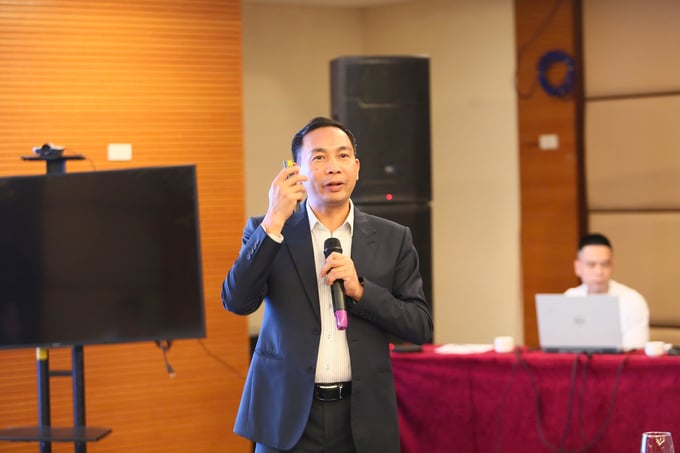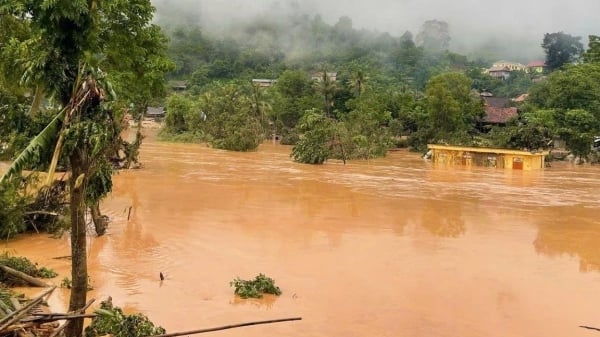July 25, 2025 | 10:46 GMT +7
July 25, 2025 | 10:46 GMT +7
Hotline: 0913.378.918
July 25, 2025 | 10:46 GMT +7
Hotline: 0913.378.918

Dr. Pham Duc Phuc shared the 5 principles of risk communication at the workshop connecting researchers, journalists and the community in the animal-based food value chain. Photo: NNVN.
The first principle emphasizes that the information provided must be accurate, clear and easily understandable. In the context of food safety and public health risk management, any misinformation or misleading data can have severe consequences.
Dr. Pham Duc Phuc, Director of the Institute of Environmental Health and Sustainable Development, highlighted the importance of public transparency in health-related matters: "Government agencies and relevant authorities must always disclose information about issues affecting public health. For instance, when a contaminated food product is identified, these agencies must make the details of the product’s origin, the potential level of danger it poses, and the health risks it could cause fully available to the public".
He further added, "Transparent communication also means being open and honest about things that are not yet certain".
In addition to making information transparent, authorities need to show empathy towards the community by tailoring their messages to match the culture, language and level of awareness of each specific audience. For example, in rural areas, information regarding the risks of food from unknown or unreliable sources should be communicated using simple and straightforward language that is easy for people to understand and apply in their daily lives.
If the message is overly complex or filled with technical terms that are difficult for the average person to comprehend, it could lead to confusion, misunderstanding, or even panic.
Providing information as early as possible is an essential factor in effective risk communication. Timely communication not only serves to protect public health but also helps to prevent unnecessary panic or confusion.
However, one of the significant challenges in risk communication is the inconsistency of messages coming from various sources. When different authorities or organizations provide conflicting information, it can create confusion and misunderstanding within the community. Particularly when scientific terms are not used consistently or are misinterpreted, it can result in unpredictable consequences.
Dr. Pham Duc Phuc provides an example of such misunderstanding, using the misunderstanding surrounding "swine flu." In the past, when the H1N1 influenza virus was widely publicized, people mistakenly believed that eating pork could lead to infection. As a result, many stopped consuming pork out of fear, even though the virus had no relation to pork consumption.
To enhance the credibility of the information, authorities should reference studies and specific data from well-established and reputable organizations, such as reports from the Ministry of Health or scientific research regarding the potential risks of a particular food. This approach not only bolsters the trustworthiness of the information being communicated but also helps the public better understand the gravity of the risks being discussed.
Dr. Pham Duc Phuc further explained in an interview with the Vietnam Agriculture Newspaper that trustworthy scientific evidence for communicators can include official electronic scientific research papers and international scientific databases. By integrating these credible sources into communication efforts, the overall effectiveness of risk communication can be improved. Moreover, relying on such evidence ensures that the public receives the most accurate and up-to-date information available, ultimately aiding in better risk management and prevention.
Lastly, encouraging community participation is an essential element in risk assessment and management. The active involvement of the public plays a crucial role in providing authorities with a more accurate understanding of the community's concerns, fears, and level of awareness. This insight allows for more informed decisions when it comes to risk management strategies.
Additionally, creating opportunities for the public to ask questions, express opinions, and share feedback is not only important for transparency but also greatly enhances the overall effectiveness of communication efforts.
Translated by Phuong Linh

(VAN) Deputy Prime Minister Le Thanh Long proposed expanding cooperation between Vietnam and Senegal's Ministry of Water and Sanitation in the fields of irrigation and water resources.

(VAN) The aftermath of Typhoon Wipha has caused severe damage to the border areas of Nghe An province. My Ly commune is among the most heavily affected.

(VAN) More than 115 agrifood experts, government advisors and business leaders are calling for animal-source foods to be excluded from a UN declaration to eliminate trans-fatty acids.

(VAN) At the 17th Partnership Council Meeting of the Partnerships in Environmental Management for the Seas of East Asia (PEMSEA), Vietnam presented a variety of marine management and protection initiatives and experiences.

(VAN) Phong Nha - Ke Bang is the largest national park in Vietnam, spanning over 123,000 hectares, and is recognized as one of the world's 200 most significant centers of biodiversity.

(VAN) VAN News features an Op-ed by Pauline Tamesis and Ramla Khalidi, reflecting on the UN Secretary-General’s call for bold climate action in 'A Moment of Opportunity: Supercharging the Clean Energy Age.'

(VAN) From July 23 to August 6, Vietnamese consumers can enjoy shopping while exploring unique American cuisine at MM Mega Market Thang Long.